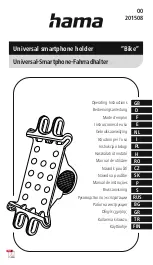
8
Supporting measures to avoid EMC problems:
1. Grid power supply
-
If electromagnetic interference occurs despite a grid connection that complies
with regulations, take additional measures (e.g., use a suitable grid filter).
2. Control lines
-
Keep them as short as possible
-
Route them close together (also to avoid EMF problems)
-
Route them far from other lines
3. Equipotential bonding
4. Shield, if necessary
-
Shield other devices in the vicinity
-
Shield the entire welding installation
EMF measures
Electromagnetic fields may cause health problems that are not yet known:
-
Effects on the health of persons close by, e.g., those with pacemakers and hearing
aids
-
Persons with pacemakers must seek advice from their doctor before staying in the im
-
mediate vicinity of the device and the welding process
-
Keep distances between welding cables and the head/torso of the welder as large as
possible for safety reasons
-
Do not carry welding cables and hosepacks over one's shoulder or wrap them around
one's body or body parts
Safety Measures
at the Setup Loca
-
tion and During
Transport
A toppling device can be deadly! Set up the device securely on an even, solid surface
-
The maximum permitted tilt angle is 10°.
Special regulations apply in areas at risk of fire or explosion
-
Follow the appropriate national and international regulations.
Use instructions and checks within the company to ensure that the vicinity of the workplace
is always clean and organized.
Only set up and operate the device in accordance with the protection class shown on the
rating plate.
Take care to ensure that the applicable national and regional guidelines and accident pre
-
vention regulations are observed when transporting the device, especially guidelines con
-
cerning hazards during transport and shipment.
It is essential to conduct a visual inspection of the device to check for damage after it has
been transported but before commissioning. Have any damage repaired by trained service
technicians before commissioning the device.
Safety Measures
in Normal Opera
-
tion
Only operate the device when all safety devices are fully functional. If the safety devices
are not fully functional, there is a danger of:
-
Serious or fatal injury to the operator or a third party
-
Damage to the device and other material assets belonging to the operating company
-
Inefficient operation of the device
Safety devices that are not fully functional must be repaired before the device is switched
on.
Never bypass or disable safety devices.
Before starting up the device, ensure that no one can be put in danger.









































